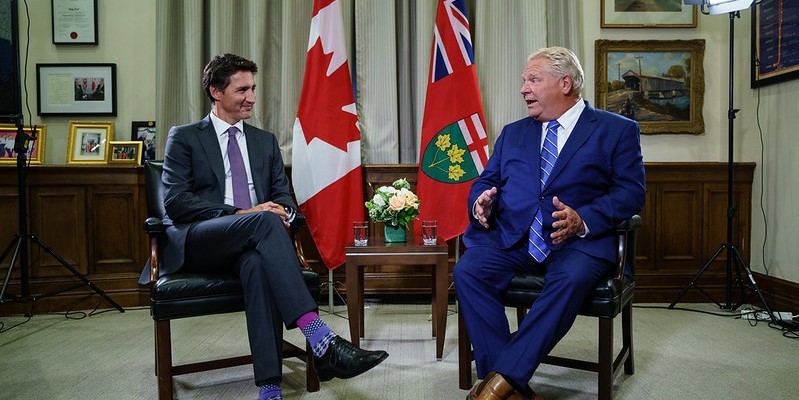Ford and Trudeau share affection for spending and taxes

Recently, Ontario Premier Doug Ford and Prime Minister Justin Trudeau came together to announce massive government subsidies for Honda to build electric vehicles and an EV battery plant in Ontario. During the funding announcement, the prime minister heaped praise on Premier Ford, describing him as an “outstanding partner” and “strong leader.”
Despite their different party affiliations, this praise should come as no surprise. The Ford and Trudeau governments share an affection for corporate welfare. However, that’s not the only similarity. The two governments largely operate out of similar policy playbooks when it comes to spending, government debt and taxes.
Let’s first look at spending. The Trudeau government came to power promising to increase spending in several areas. A few years later the Ford government took office while taking a very different rhetorical tack, promising to cut spending that, Ford argued, had been profligate under former Ontario premier Kathleen Wynne.
Since taking power, however, both governments have chosen to increase spending compared to levels they inherited from their predecessors. Since 2015/16, the Trudeau government has increased per-person program spending by 20 per cent (after adjusting for inflation). While the Ford government’s spending growth has been slower (up 2.1 per cent between 2018/19 and 2023/24, after adjusting for inflation), it broke its commitment to reduce spending.
On deficits and debt, the two governments’ track records are also more similar than different. Thanks largely to their shared failure to control spending, both governments have run operating deficits almost every year in power (the only exception was 2021/22 in Ontario due to a surprise influx of revenue following the pandemic). This year, both the Trudeau government ($40 billion) and the Ford government ($9.8 billion) and will run budget deficits. Moreover, once you add in spending on long-term capital projects, the Ford government expects a net debt increase of $24.2 billion this year alone.
Both governments also share a willingness to maintain high taxes. The Ford government came to power promising substantial tax relief. Instead, Ontarians have seen no major tax reduction initiatives under Ford, and provincial tax revenue (as a share of the economy) has actually grown. Meanwhile, the Trudeau government has implemented a number of tax hikes including the recent increase to the capital gains inclusion rate.
Indeed, this latest development illustrates the similarities between the two governments when it comes to taxes. Although the decision to raise the inclusion rate was made by the Trudeau government, it’s properly viewed as both a federal and provincial tax increase because both levels of government share the same definition of income. In other words, the provincial “share” of capital gains revenue will grow as well. But if Premier Ford rejected the Trudeau government’s tax-friendly approach to governance, his government could simply cut other provincial taxes to keep Ontario’s overall revenue levels the same while leaving more money in the pockets of Ontario residents and businesses. There’s been no indication this will happen. Instead, Premier Ford will go along with Prime Minister Trudeau’s tax hike and keep the province’s share at Queen’s Park where it can be used to finance government spending.
To be sure, the fiscal policy approaches of Ford and Trudeau are not identical. The Trudeau government is more active in its pursuit of additional tax revenue and more spending while the Ford government is more passive, leaving high tax rates and spending levels where they are and shrugging its collective shoulders at large deficits and debt accumulation. However, the two governments’ fiscal approaches have many similarities. Don’t be surprised to see more joint press conferences and praise between the two leaders in the future.

